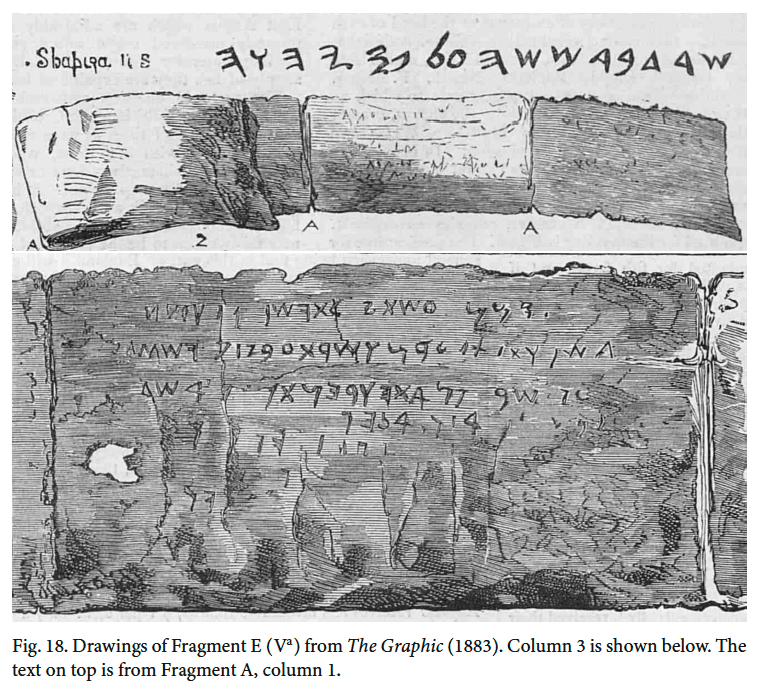Criticism about the Book of Mormon’s references to the Red Sea came up in some recent comments, so I thought I’d share a couple of perspectives that might be helpful on that topic. There are a couple of arguments regarding the Red Sea that are made to criticize the Book of Mormon. First, it is often said that the Book of Mormon is just copying a KJV mistake in stating that the Israelites crossed the Red Sea, when it really should be the Reed Sea. Second, the Book of Mormon’s use of Isaiah 9:1 in 2 Nephi 19:1 appears to mistakenly change “the sea” to “the Red Sea” when the Red Sea is not meant by Isaiah. I’ll consider both arguments below, drawing upon my LDSFAQ page, “Questions about Apparent Problems in the Book of Mormon.”
Please note the update from Oct. 20, 2019 below for Point #2. Thanks to great input from two readers, “ATV” and Robert Boylan, I must retreat on my previous position about a scribal error from Oliver Cowdery being a likely explanation for the “Red” in 2 Nephi.
1. Red Sea vs. Reed Sea
The argument here is that the Book of Mormon appears to have a mistake “borrowed” from the King James Version. Many scholars now say that the body of water Moses and the Israelites crossed should be called the Reed Sea, not the Red Sea. Since the Book of Mormon also has this mistake, it suggests the concept was lifted from the King James rather than translated from an accurate ancient text. But the argument fails. For one thing, the two terms, Red Sea and Reed Sea, can be interchanged. Scott J. Pierson received the following explanation from a professor of the Oriental Institute at Chicago University, which I quote with permission (pers. corresp., Nov. 1999):
The Gulf of Suez, or the Red Sea, was known as the Yam Suf, the Sea of Reeds, though this name also covers the stretch of land from the head of the Gulf across the land to the Mediterranean Sea. We do not know if the Gulf of Aqaba was named as a separate entity, and if it was what its name would have been.
D.C. Pyle also offers this insight:
Funny thing is, there are critics of the Church who claim that the Book of Mormon is false because it does not mention the Sea of Reeds when referring to the Red Sea in recounting the Exodus. It is true that the phrase _ym swp_ does literally mean Sea of Reeds. It is also true that the various Biblical scholars are saying that the Sea of Reeds is not the Red Sea.
However, the biblical scholars who make such claims are all wet, in my opinion. Why? First of all, the ancient Greeks called what we know as the Red Sea combined with the Indian Ocean, “Red Sea.” Lastly, the Bible text itself plainly states that Eloth (modern Elath [at the northern end of the Gulf of Aqaba, part of the Red Sea]) was on the shore of _ym swp_ (1 Kings 9:26)! Since _Red Sea_ is our modern equivalent for both the Hebrew term and location, it is perfectly acceptable and logical for the Book of Mormon to contain it as it does.
2. Does 2 Nephi 19:1 incorrectly change “the sea” in Isaiah 9:1 to “the Red Sea”?
Update, Oct. 20, 2019: Thanks to excellent feedback from readers, I must admit my error in previously concluding that a scribal error from Oliver Cowdery was the best explanation for the added “Red” in 2 Nephi 19:1. What follows is a revised response. The original response included these statements, which I no longer accept:
This may be a legitimate problem, perhaps a scribal or copying error from Oliver Cowdery, as John Tvedtnes has argued, though there’s an argument that it may be acceptable….
Personally, I suspect John Tvedtnes is right on this point (see “2 Nephi 19:1. Red Sea” in Book of Mormon Research):
In studying the Isaiah variants in the Book of Mormon, it becomes clear that there are a few scribal and printer’s errors. I am convinced that the addition of “Red” in 2 Nephi 19:1 was an overcorrection by Oliver Cowdery, who, as scribe to Joseph Smith during the translation of the Book of Mormon, was probably influenced by the fact that he had already written about the Red Sea in a number of earlier passages (1 Nephi 2:5, 8-9; 4:2; 16:14; 17:26-27).
Here’s my new response:
I originally felt this was likely a scribal error from Oliver Cowdery, but there are some good reasons to believe the source of this was the ancient Book of Mormon itself, whether or not it’s what Isaiah intended.
In the Book of Mormon, 2 Nephi 19:1 reads:
Nevertheless, the dimness shall not be such as was in her vexation, when at first he lightly afflicted the land of Zebulun, and the land of Naphtali, and afterwards did more grievously afflict by the way of the Red Sea beyond Jordan in Galilee of the nations. [emphasis added]
This verse is a quotation of Isaiah 9:1, which reads in the KJV as follows:
Nevertheless the dimness shall not be such as was in her vexation, when at the first he lightly afflicted the land of Zebulun and the land of Naphtali, and afterward did more grievously afflict her by the way of the sea, beyond Jordan, in Galilee of the nations.
The Book of Mormon deletes “her” from the KJV and changes “sea” to “Red Sea.” Based on verse 1 in light of verse 2 from Isaiah 9, many people conclude that the sea is the Sea of Galilee, not the Red Sea. The KJV for Isaiah 9:2 is:
The people that walked in darkness have seen a great light: they that dwell in the land of the shadow of death, upon them hath the light shined.
So yes, this does appear to be a prophecy of the ministry of Christ, and the Sea of Galilee would make sense. So why does the Book of Mormon have the puzzling reference to the Red Sea? Here is a possible explanation offered by D. Charles Pyle in e-mail received June 2004:
There are those who say that this is an error. It is possible that it is a scribal error on the part of Oliver Cowdery in copying the printer’s manuscript from the original manuscript. The problem is that this cannot be proven or disproven because this portion of the original manuscript no longer is extant. It also is possible that the Egyptian textual translation of the Hebrew is in error and that Joseph Smith translated it, error and all. On the other hand, it also is possible that it is not an error at all.
The King’s Highway also was part of what was known in ancient times as the Way of the Red Sea, which led out of Egypt along the shores of the Red Sea, passed through Edom and changed direction after meeting with the Way of the Sea, in Galilee, to go into Mesopotamia. It is possible that Joseph journeyed this way, or at least part of this way, to avoid going through Judaea when he took Jesus into Nazareth as a young child. If so, it would be quite correct in that the light would pass into the region of Naphtali via the Way of the Red Sea. Joseph sought to avoid contact with Archelaus and a back route would be one of the best ways to avoid contact.
We also know that Jesus went into the wilderness for his temptation after being baptized in a region on the other side of the Jordan. The English Book of Mormon has Bethabara as do several versions of the Bible while [several other translations have] Bethany beyond Jordan. He would then have come down from Galilee to be baptized on the other side of the Jordan (east of the river; ‘beyond Jordan’ meant to the east of the Jordan River), and come down around the Way of the Red Sea and around the Dead Sea to the Wilderness of Judaea. Remember, Jesus’ wandered the wilderness for forty days, plenty of time to travel around the Dead Sea in that manner, that region being one the most inhospitable in the main. There are possible hints that Jesus came through Edom or Idumea. One way that he could have done so is to travel the Way of the Red Sea, which passes through Edom. The records of Jesus’ life and travels are scanty at best and it is impossible to know for certainty at this time. In any case, I am not willing to state without good evidence that this passage is in error with any degree of certainty, for in my opinion there is no certainty either way. I have sifted through much contradictory ‘evidence’ and have formed no solid conclusion on this textual matter.
While we’re not really sure, it is possible that the phrase “by the way of the Red Sea” could properly correspond to what Isaiah intended, suggesting that the Book of Mormon verbiage here could have been plausible in an ancient scriptural record.
On the other hand, John Tvedtnes has argued that the addition of “Red” was likely a scribal error from Oliver Cowdery (see “2 Nephi 19:1. Red Sea” in Book of Mormon Research), a position I originally accepted as likely:
In studying the Isaiah variants in the Book of Mormon, it becomes clear that there are a few scribal and printer’s errors. I am convinced that the addition of “Red” in 2 Nephi 19:1 was an overcorrection by Oliver Cowdery, who, as scribe to Joseph Smith during the translation of the Book of Mormon, was probably influenced by the fact that he had already written about the Red Sea in a number of earlier passages (1 Nephi 2:5, 8-9; 4:2; 16:14; 17:26-27).
Yes, errors in scripture are possible and must be expected in any work that goes through the hands of mortals, including original authors, editors, translators, copyists or scribes and typesetters. However, there are some good reasons to doubt that this was a mistake introduced by Oliver Cowdery. In the extremely thorough and thoughtful analysis of the Book of Mormon text in Royal Skousen’s Analysis of Textual Variants of the Book of Mormon (Critical Text of the Book of Mormon), Part Two: 2 Nephi 11 – Mosiah 16 (2005), there is extremely thorough analysis of various aspects of 2 Nephi 19:1. You can read the relevant section on a file kindly provided at The Interpretor Foundation website, where we find this regarding the question of the intruding word “Red”:
The Book of Mormon reads “by the way of the Red Sea” rather than the King James “by the way of the sea”. John A. Tvedtnes has argued that the extra red is an error (see page 45, “The Isaiah Variants in the Book of Mormon”, FARMS preliminary report, 1984 [a related resource from Tvedtnes is “Isaiah in the Bible and the Book of Mormon,” Review of Books on the Book of Mormon 16/2 (2004)]). The context implies that this sea is the Sea of Galilee, especially since the inheritance for the tribes of Zebulun and Naphtali was in this region (as described in Joshua 19). Note, in particular, that when this prophecy of Isaiah’s is quoted in the New Testament, “the sea” is definitely interpreted as referring to the Sea of Galilee:
Matthew 4:12–15
now when Jesus had heard that John was cast into prison
he departed into Galilee
and leaving Nazareth he came and dwelt in Capernaum
which is upon the sea coast
in the borders of Zabulon and Nephthalim
that it might be fulfilled
which was spoken by Esaias the prophet saying
the land of Zabulon and the land of Nephthalim
by the way of the sea
beyond Jordan
Galilee of the Gentiles
Tvedtnes argues that the change to Red Sea derived from previous references in the Book of Mormon to the Red Sea: “This appears to be a case of scribal overcorrection, due to prior mention of the Red Sea in the [Book of Mormon] text.” The examples in 1 Nephi, however, do not show any particular similarity to the phraseology in 2 Nephi19:1. In particular, the word way never collocates with Red Sea:
1 Nephi 2:5 by the borders near the shore of the Red Sea
1 Nephi 2:5 in the wilderness in the borders which was nearer the Red Sea
1 Nephi 2:8 and it emptied into the Red Sea
1 Nephi 2:9 the waters of the river emptied into the fountain of the Red Sea
1 Nephi 4:2 for he truly spake unto the waters of the Red Sea
1 Nephi 4:2 and were drownded in the waters of the Red Sea
1 Nephi 16:14 which was in the borders near the Red Sea
1 Nephi 17:26 the waters of the Red Sea was divided hither and thither
1 Nephi 17:27 the Egyptians were drowned in the Red Sea
A more likely source for the intrusive red in the Book of Mormon text is the explicit phrase “by the way of the Red Sea”, which occurs four times in the King James Bible:
Numbers 14:25
tomorrow turn you and get you into the wilderness by the way of the Red Sea
Numbers 21:4
and they journeyed from mount Hor by the way of the Red Sea to compass the land of Edom
Deuteronomy 1:40
turn you and take your journey into the wilderness by the way of the Red Sea
Deuteronomy 2:1
then we turned and took our journey into the wilderness by the way of the Red Sea
It appears that familiarity with this specific phrase led to replacing sea with Red Sea in 2 Nephi 19:1. This proposal implies that the intrusive red (actually /suf/ ‘reed’ in the original Hebrew) may have originally been on the plates of brass or that Nephi himself added the word as he copied the Isaiah text from the plates of brass onto his small plates. Further, there is no evidence within the Book of Mormon manuscripts themselves that any of the scribes ever added red to the word sea (out of 82 occurrences), even as an initial error that was immediately corrected. This evidence suggests that the intrusive red in 2 Nephi 19:1, even though it may be a mistake, is a part of the original Book of Mormon text. Thus the critical text will maintain the earliest textual reading, “by the way of the Red Sea”.
Summary: Maintain the use of “by the way of the Red Sea” in 2 Nephi 19:1; the intrusion of the word red before sea seems to be in the original text of the Book of Mormon.
The detailed analysis of context and language in ATV (Analysis of Textual Variants) is greatly appreciated. Thanks to the anonymous “ATV” who pointed out what the ATV had to say.
Finally, the plausibility of “by the way of the Red Sea” as part of an ancient scriptural record drawing upon Isaiah 9 may be enhanced by look at another ancient example of such language. Robert Boylan made this comment in response to my original post:
Interestingly, in The Chaldee paraphrase of the Prophet Isaiah by Jonathan ben Uzziel, we read the following from Isa 9:1 (italics in original):
For none shall be weary who shall come to oppress them, as at the former times, when the people of the land of Zebulun, and the people of the land of Naphtali, went into captivity: and those that were left, a mighty king led into captivity, because they did not remember the power of the Red Sea, neither the wonders of the Jordan, the war of the fortifications of the nations.[1]
What is interesting about this text is that the translator, C.W.H. Pauli, added “Red” to “Sea,” something that also appears in 2 Nephi 19:1 and its version of Isa 9:1. Perhaps Joseph Smith or the translator of the Isaiah text on the brass plates added “Red” as a clarification as to which location was intended by the prophet Isaiah.
[1] The Chaldee Paraphrase of the Prophet Isaiah (trans. CW.H. Pauli; London: London Society’s House, 1871), 29-30; online at https://archive.org/stream/chaldeeparaphra00uzzigoog#page/n44/mode/2up
Fascinating! No need to feel blue over this use of the Red Sea in the Book of Mormon.
The entire ATV is online at the Interpreter Foundation website. See their announcement and links to all six sections of the volume. A remarkable resource that I need to use more!
Related resources:
- “King’s Highway and Way of The Sea,” Early World History (blog), March 2012, http://earlyworldhistory.blogspot.com/2012/03/kings-highway-and-way-of-sea.html.
- “King’s Highway,” Wikipedia, https://en.wikipedia.org/wiki/King%27s_Highway_(ancient).












Another steaming helping of pure nonsense. No thanks, Jeff! 40 years was enough!
Anon 11:14 – Now that is feeling red about a blue sea. Twister may be currently marketed as a kids game, but for adults it is a great calisthenic, and can put in the mood. If playing is causing you pain, it is only because you are playing it wrong, not following the instructions, you have a medical condition you did not consult your doctor about before playing. Or you have sour grapes, you keep losing so you blame the game instead of yourself.
"This verse is a quotation of Isaiah 9:1" "This may be a legitimate problem" "The problem is that this cannot be proven or disproven " : Darn if only a prophet seer and revelator could clear this all up …. guess I will have just wait just a little bit longer until I am issued my own seer stone, but then I will will be too busy looking up things like who really killed JFK …
"was lifted from the King James rather than translated from an accurate ancient text" : !!!, you are challenging official publications, for example September 1977 Ensign citing Dnaiel Ludow, which suggests that Joseph may have adopted the Isaiah passages wording from the King James.
Lifting from the KJV means that the BoM is not what it claims to be!!! And you have not been excommunicated? Hum, excommunication must not be about what one says, but how they say it. Now that sounds like part of the product attributable to fallible human hands …
"there's an argument that it may be acceptable" : Of course there is, there always is. Just watch the youtube videos of an artist given a doodle of what appears to be an "inappropiate" image and then the artist draws all around it until it is no longer "inappropiate". With a little bit of pratice anyone can do it.
"the concept of" …. "divine aid" … "through fallible human hands" : Given many religions belief this describes every product of humanity, many religions agree with you on this descriptor of the BoM. The ancient Romans would not have a called Joseph Smith a genius, they would have said Genius visited him.
"deliberately changing "sea" to "Red Sea" would make no sense. " : "deliberately"? Now that misdirection is a great way to pull the mental hamstring just right.
Here's what ATV has on the subject.
Tvedtnes argues that the change to Red Sea derived from previous references in the Book of Mormon to the Red Sea: “This appears to be a case of scribal overcorrection, due to prior mention of the Red Sea in the [Book of Mormon] text.” The examples in 1 Nephi, however, do not show any particular similarity to the phraseology in 2 Nephi 19:1. In particular, the word way never collocates with Red Sea:
Examples.
A more likely source for the intrusive red in the Book of Mormon text is the explicit phrase “by the way of the Red Sea”, which occurs four times in the King James Bible:
Examples.
It appears that familiarity with this specific phrase led to replacing sea with Red Sea in 2 Nephi 19:1. This proposal implies that the intrusive red (actually /s¯uf/ ‘reed’ in the original Hebrew) may have originally been on the plates of brass or that Nephi himself added the word as he copied the Isaiah text from the plates of brass onto his small plates. Further, there is no evidence within the Book of Mormon manuscripts themselves that any of the scribes ever added red to the word sea (out of 82 occurrences), even as an initial error that was immediately corrected. This evidence suggests that the intrusive red in 2 Nephi 19:1, even though it may be a mistake, is a part of the original Book of Mormon text. Thus the critical text will maintain the earliest textual reading, “by the way of the Red Sea”.
ATV, that makes a lot of sense! This is related to Pyle's view on it being something either on the brass plates or from Nephi, and you help explain how that may have happened. Many thanks!
Hi Jeff.
Interestingly, in The Chaldee paraphrase of the Prophet Isaiah by Jonathan ben Uzziel, we read the following from Isa 9:1 (italics in original):
For none shall be weary who shall come to oppress them, as at the former times, when the people of the land of Zebulun, and the people of the land of Naphtali, went into captivity: and those that were left, a mighty king led into captivity, because they did not remember the power of the Red Sea, neither the wonders of the Jordan, the war of the fortifications of the nations.[1]
What is interesting about this text is that the translator, C.W.H. Pauli, added "Red" to "Sea," something that also appears in 2 Nephi 19:1 and its version of Isa 9:1. Perhaps Joseph Smith or the translator of the Isaiah text on the brass plates added "Red" as a clarification as to which location was intended by the prophet Isaiah.
[1] The Chaldee Paraphrase of the Prophet Isaiah (trans. CW.H. Pauli; London: London Society's House, 1871), 29-30; online at https://archive.org/stream/chaldeeparaphra00uzzigoog#page/n44/mode/2up
ATV, oh, right: ATV = Analysis of Textual Variants of the Book of Mormon (Critical Text of the Book of Mormon), and in particular, Part Two: 2 Nephi 11 – Mosiah 16. Mercifully, a PDF of the relevant portion is available at The Interpreter Foundation website. I am quite impressed by the analysis and must conclude that this is the best option for understanding 2 Nephi 19:1. Likely to have been original, whether from Mormon or Nephi or the brass plates, and NOT Oliver's scribal error. Very nice.
And Robert, that's also an interesting angle that is consistent with the position taken in the ATV, but adds a great example in support of what is in the Book of Mormon. Many thanks!